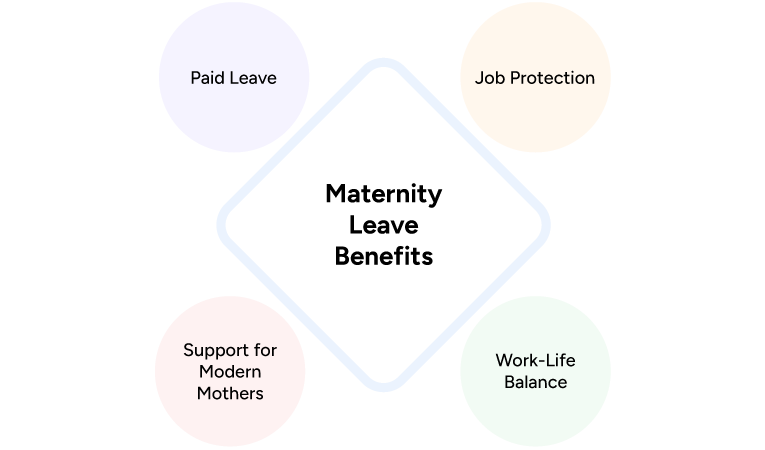Maternity Leave in India: Rules, Benefits & Eligibility

Table of Contents
Key Takeaways
- Maternity leave is the paid/unpaid time off work offered to a woman around the period of childbirth/adoption to recover and care for her child.
- Maternity leave in India is governed by the Maternity Benefit Act 1961, amended in 2017. The act applies to establishments with 10 or more employees, where women must have worked at least 80 days in 12 months.
- The duration of paid maternity leave is 26 weeks for the first two children, with up to 8 weeks allowed before the expected delivery date. The leave duration is 12 weeks for the third child/subsequent children/adoption/surrogacy.
- In case of miscarriage or medical termination of pregnancy, 6 weeks of leave is offered to women.
- Maternity benefits offered are full salary payment and complete job protection during leave. Companies with 50 or more employees should provide crèche facilities and work-from-home arrangements.
- Maternal leave challenges for both employers include an overall reduction in efficiency and productivity.
Understanding multiple rules and eligibility criteria for maternity leave can be challenging. This is because many women are unsure about their rights and job security during pregnancy.
Companies that prioritize a supportive work environment for women should be aware of their pregnancy leave policies and stay current to avoid compliance issues. This article outlines the current rules and eligibility criteria for pregnant women, as well as the maternity leave benefits available in India.

What is Maternity Leave in India?
Maternity leave is a period of paid time off from work for pregnant women employees, as provided under the Maternity Benefit Act, 1961. It is a legally protected absence from work for female employees during pregnancy and after childbirth.
Maternity Benefit Act, 1961
The maternity leave policy and its benefits are regulated under the Maternity Benefit Act, 1961. Some key highlights of the act include:
- Scope: This act applies to all establishments that employ 10 or more employees. This includes factories, shops, mines, plantations, and other organizations.
- Paid Leave: Pregnant women are entitled to paid maternity leave, along with other benefits, during the leave period. The leave can be taken before and after the child is delivered for up to 6 months (26 weeks).
- Job Security: During the leave period, employers cannot fire/demote, or mistreat a woman employee. They must reinstate them in their original job position upon return.
Maternity Benefit Act, 2017
The Maternity Benefit (Amendment) Act, 2017, was introduced with multiple provisions. This includes provisions related to maternity leave and its benefits. These are:
- Extension of Pregnancy Leave Duration: This leave can be taken 8 weeks before the delivery date and 18 weeks after delivery. For the third/subsequent child, the pregnant woman is given 12 weeks of leave.
- Leave for Surrogate and Adoptive Mothers: For adoptive mothers who adopt a child below 3 months of age/commissioning mothers (surrogacy), the maternity leave duration is 12 weeks.
- Option to work from home: The act provides an option for new mothers to work from home after the maternity leave period. This arrangement includes factors such as the nature of work and mutual agreement between the parties.
- Creche facilities: This act also provides childcare services or crèche facilities for all businesses with 50 or more employees. Mothers are allowed to visit the facility four times a day, including breaks.
Maternity Leave Policy in India (Sector Vise)
There are multiple sectors that have different approaches to maternity leave policy. Here is how maternity leave provisions work across industries and what companies need to know.
- Public Sector: Public organizations offer 26 weeks of leave (for the first two children) along with additional leave options and childcare facilities. With this, male government employees also get paternity leave in India for improved work-life balance and shared parental duties.
- Private Sector: Private companies offer flexible pregnancy leave benefits, which include 26 weeks of leave (for the first two children) with additional benefits, including crèche facilities and nursing breaks.
- Unorganized Sector: Pregnant women have limited access to maternity benefits, which include schemes under the Employees’ State Insurance (ESI) and the Pradhan Mantri Matru Vandana Yojana.
- Specialized Industries: Certain industries adopt a customized approach, for example, flexible work-from-home arrangements in the IT sector. Manufacturing industries are assigning lighter tasks during pregnancy.

Who is Eligible to Apply for Maternity Leave in India?
The eligibility criteria to provide support to pregnant working women are:
| Eligibility | Leave Duration | Additional Notes |
|---|---|---|
| First 2 Children | 26 weeks (up to 8 weeks pre-delivery). | Applies to establishments with 10 or more employees. |
| 3rd Child Onwards | 12 weeks (6 weeks pre-delivery). | Reduced leave for third and subsequent children. |
| Adoptive Mother (Child under 3 Months) | 12 weeks from the date the child is handed over. | Eligible for women adopting an infant below 3 months. |
| Commissioning Mother (Surrogacy) | 12 weeks from the date care is assumed. | Surrogate commissioning mothers are eligible. |
| Miscarriage/Abortion | 6 weeks from the date of miscarriage. | Paid leave granted for medical termination of pregnancy or miscarriage. |
| Tubectomy (After Sterilisation Surgery) | 2 weeks | Post-surgery recovery leave following sterilisation. |
| Prenatal Leave | Limit up to 8 weeks before delivery. | Leave taken before delivery is included in the total leave duration. |
Maternity Leave Benefits in India
Pregnant women working under pressure during work is not a good practice, which is where this type of leave becomes essential. The importance of this leave ensures the well-being of the mother and her child. Some of these maternity leave benefits for pregnant mothers are:

Paid Leave: Any pregnant woman on leave is entitled to receive full pay as per the Maternity Benefit Act, 1961. They also receive medical benefits, which help maintain their financial stability.
Job Protection: Employers cannot dismiss/fire female employees during this type of leave. They are given assurance that the same or an equivalent job position will be offered post-maternity leave.
Work-Life Balance: It allows women to take time off after delivery while continuing their job/employment. This promotes a smooth transition into motherhood and maintains career progression.
Support for Modern Mothers: This includes biological mothers, along with adoption and surrogacy.
Maternity Leave Rules in India
maternity Leave Rules are Governed by the Maternity Benefit Act (1961), Followed by Its Amendment in 2017. there are Multiple Rules that Employers Must Follow to Remain Compliant with Indian Labor Laws. Some of the Key Details to Focus on are:
- Timing of Leave: Expectant mothers can start their leave 8 weeks before their delivery date. After childbirth, women can take leave for the remaining weeks to attend to their personal needs.
- Employer Communication: Pregnant employees should inform their employer of their plans for maternal leave in advance. This helps employers plan for temporary recruitment and ensure business continuity.
- Documentation Requirements: A medical certificate must be provided to the company, confirming the pregnancy and the expected delivery date. These can be easily created with factoHR’s maternity leave letter template, and details can be added to the document.
- Employer Responsibilities: There are multiple employer responsibilities, for example:
- Financial Support: Employers must pay an employee’s entire salary once they receive proof of pregnancy to support female employees during this phase of life.
- Post-Delivery Payment: Employers are required to clear post-delivery wages in a lump sum within two days of receiving proof of childbirth.
- Task Allocation: Once female employees have resumed their work, employers are not supposed to assign heavy tasks. These include activities like standing duties and overtime work.
- Creche Facilities: Organizations with 50 or more employees should provide a crèche facility for mothers to visit their child during work hours.
- Medical Certificates: These certificates are essential paperwork required for the processing of maternity benefits. These include pre-delivery certificates and post-delivery certificates.

Maternity Leave Challenges for Employers and Employees in India
Maternity leave rules are quite significant, but they come with their own set of challenges for both employers and employees. These are discussed below:
For Employers
- Decreased Productivity: When pregnant mothers go on leave, the organization’s productivity is affected.
- Workforce Management: When employees take this type of leave, it becomes difficult for employers to redistribute tasks or hire temporary replacements.
- Financial Strain: For startups and SMEs, this change can be costly and may result in a financial burden.
- Compliance and Legal Risks: There are multiple companies that struggle with staying updated with legal laws and those that can lead to fines/penalties.
- Retention Concerns: Companies face retention issues about whether an employee will return to work after these types of leave.
For Employees
- Career Setbacks: Even with legal protection, many women fear demotion from projects or experience delayed promotion while taking leave.
- Workplace Discrimination: Many male-dominated or conservative companies pressure women to resign or are sidelined after their return from leave.
- Lack of Awareness: There are many female employees who are unaware of their leave rights and benefits under Indian law.
- Challenges in Reintegration: When female employees return to work after leave, catching up on developments can be challenging.
Maternity Leave for Government Employees in India
- The central government rules, and the Maternity Benefit Act governs maternity benefits for government employees.
- The leave provisions and benefits are offered to all women along with defined working hours in the government sector.
- Pregnant women can take leave for 26 weeks during pregnancy and the delivery of the child.
- From these 26 weeks, 8 weeks of leave can be taken before the delivery date, and can be extended up to 26 weeks after the delivery.
- For adopting mothers, the child should be below 3 months, and 12 weeks of leave can be taken.
- Commissioning mothers can also take 12 weeks of leave after the child is handed over to the mother.
How does factoHR Help You Manage Maternity Leave?
Maternity Leave rules have policies that combine both legal and financial support to female employees. According to industry norms and workplace needs, these new accommodations are made during this phase of a woman’s life.
The act and leave laws aim to create a positive environment for maternal health and child well-being. factoHR’s Leave Management System helps businesses in India manage everything, including maternity leave. Some core features of factoHR’s LMS are:
- Employee Self-Service Portal (ESS)
- Customizable Leave Policy Template
- Customizable Approval Workflows
- Integration with the Payroll and Attendance System

Frequently Asked Questions
Is Maternity Leave Paid or Unpaid?
Maternity Leave is paid leave, where female employees receive full compensation during their leave period.
Is Maternity Leave 6 or 9 Months?
Pregnancy leave is 26 weeks, which is about 6 months (not 9 months). This can be taken up to 8 weeks before and 18 weeks after delivery.
Can I have 12 Months Maternity Leave?
No, Maternity Leave cannot be taken for 12 months. The maximum paid leave is 26 weeks (6 months) for the first two children. This is reduced to 12 weeks from the third child onwards.
Can Maternity Leave be Extended in India?
Yes, Maternal Leave duration can be extended beyond the standard time in certain instances, for example, complications that require medical certification.
Can Maternity Leave be Taken after Delivery?
Yes, this type of leave is taken after and even before delivery. Before delivery, up to 8 weeks of leave can be taken, and the remaining leave can be taken after delivery.
Can My Employer Replace Me while on Maternity Leave?
Employers can hire someone temporarily to delegate your work during pregnancy leave to maintain business continuity, but note that they cannot dismiss you.
Are Women Eligible for Maternity Leave during the Probation Period?
Women’s eligibility depends on the company policy during probation. Female employees who have worked for at least 80 days in the 12 months are eligible.
Can Women Take Maternity Leave for a Third Child?
Yes, women can take this type of leave for a third child during and after pregnancy, with a maternity leave duration of up to 12 weeks, instead of the standard 26 weeks.
What is the Maternity Benefit Act 1961?
The Maternity Benefit Act, 1961, is a law that provides paid leave and benefits to working women in establishments with 10 or more employees.
How does the Legal Framework Support Maternity Leave?
The Maternity Benefit Act mandates paid leave and job protection during leave for pregnant women. Other additional benefits include crèche facilities and the right to receive full pay.
What is the Maternity Leave Applicability?
Pregnancy Leave applies to all women working in establishments with 10 or more employees. They should have worked for at least 80 days in the last 12 months.
Grow your business with factoHR today
Focus on the significant decision-making tasks, transfer all your common repetitive HR tasks to factoHR and see the things falling into their place.

© 2025 Copyright factoHR


